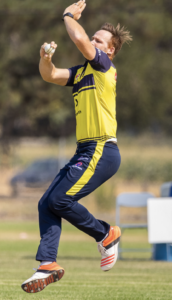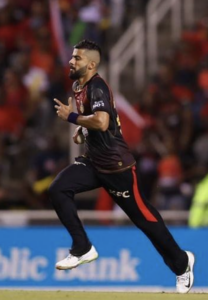While most pro athletes in this country have followed a relatively linear and predictable path in order to make it to the top of their game, there’s no template, blueprint, or well-traveled path for professional cricketers in the US. To make it to Minor League Cricket, players have had to navigate some pretty interesting routes (catch-up on parts five, six and seven for more stories). Steve Steinberg from CricAmerica sat down with a couple of world-class players who thought their cricketing days were over when they moved to the States.
Rusty Theron – East Bay Blazers
Very few Minor League Cricket players have seen as much of the cricketing world as Rusty Theron. Now, in addition to playing for the East Bay Blazers, Theron uses his international experience to help with scouting and development for Minor League and Major League Cricket.
“I was essentially just a small town kid from South Africa. Very humble beginnings. I really loved playing cricket. It was, and still is, what I do for fun. I think when other kids were going to the movies or whatever they did, I was in the nets playing with my brother for three or four hours a day. I started playing when I was about four years old and it was just me and my brother who’s about seven or eight years older than me and also a good cricketer. We used to play cricket in the yard and obviously watch it on TV and then go reenact our favorite players.”

Playing at the prestigious Grey High School in Port Elizabeth put Rusty on the local map. He began making the provincial sides for Under-15, U17, and U19 before starting to have doubts about a cricketing career. “I got a scholarship after school to go to university and I went there for about a year, but it wasn’t really the environment for me. It was away from my hometown and it was more biased towards the local players. I sort of gave up cricket for a while and my mom was like, ‘Oh, so when are you gonna get a real job?’ She organized an interview for a job at a hotel. I went in to see what’s going on and I walked through the property for about 15 minutes. And honestly, I was like, this is not what I’m meant to do with my life. I called my mother and said, ‘I’m sorry. This isn’t it. This is not what I’m supposed to do.’ And about a week later I got a call from the Warriors head coach. That’s a franchise team in South Africa.”
Recommitted to cricket, Rusty’s stock quickly rose. “In my second year with the Chevrolet Warriors, I was the second highest wicket-taker in the competition and really never looked back from there. I was called up to the IPL by Kings XI to be a replacement for Jerome Taylor, who got injured, and was on a plane to India not too long after that. I landed at 3:00 AM and played a game at 8:00 PM. We played against Chennai and it went to a Super Over. I bowled the Super Over, we won, and I was Man of the Match of my first game there. I was like, Wow. Welcome to the Big Show!”
“It all started happening very quickly after that. I got called up to play for South Africa in the World Cup in 2010 and then I got called to go and play county cricket for Sussex right after that. So it kind of all just snowballed very quickly for me. I’m obviously very grateful for it all and I managed to achieve quite a bit in a short space of time in that sense.”
An injury, though, forced Rusty to begin thinking about his post-playing days. “I’ve seen so many good players for whom life after cricket isn’t always pretty. I wanted to continue on with my studies to make sure that I have a degree and have something ready.” And after meeting his future wife while playing in the CPL in 2014, Rusty set his sights on the US, his future, and his life after cricket. “I wanted to become an English Literature professor, actually. And it turns out that’s a very long, lengthy, and very extensive process. You can do college lecturing with a master’s degree, but ultimately if you want to be a university lecturer, you have to have a PhD. And, honestly, when I looked at the rates for degrees in the US, I was like, this is gonna bankrupt me.”

Rusty was pulled back into the game in 2018 after a call from Major League Cricket and USA Cricket. “Now I find myself back in cricket, which I think, ultimately, is quite ironic because I stopped playing cricket so that I could get a head start on life after cricket. But I think life sort of works out as it should. I’ve got an undergrad in English Literature, but ultimately I’ve got the equivalent of a PhD in cricket and that’s always where I’m going to probably be making an impact or making a living.”
In addition to playing for the East Bay Blazers — and the USA men’s national team — Rusty is also very involved in the development and future of Minor and Major League Cricket. “Initially, as the pandemic started off, I took more of a central role in scouting, particularly the South African contingent. Dane Piedt, Obus Pienaar, Corne Dry, and pretty much all the South African guys that are here, I brought them here. The thinking was can they make a difference? Are they the right people to come here?”
“When the academies opened back up, I took a central role as the Major League Cricket Academy Bay Area head coach. That involved establishing the program, structuring the academy, and coaching, as well. What we want to do is set up hubs like this across the country. It’s going particularly well in the Bay Area. We have a rich ecosystem of professional cricketers. Right now, we have about seven or eight professional player/coaches.”
And Rusty sees a lot of promise and potential for the growth of Minor and Major League Cricket. “It’s about trying to grow the game. People misinterpret the purpose of the professionals that we bring in. I think a lot of the local players can see them as a threat — like somebody’s coming for your job. But ultimately, we work in sport and sport is a competitive environment. And if you’re up to the challenge of competition, you ultimately become a better player. The local players and the youth that we have coming through our academy systems are the ones that are going to have to carry cricket going forward beyond that. So my role is to help groom these kids. We have such a diverse bunch of people with guys from South Africa, Australia, India, Pakistan, Sri Lanka and everybody can just get in a room and share their own knowledge and experiences. And, honestly, when I look at the things that we offer, I mean, I never got anything near that when I was a young kid.”
Who would Rusty want to play with on his Dream XI? “Rashid Khan because I just think he’s good value as a cricketer, so he’d definitely be one of them. I like Rohit Sharma. He’s just the best batter in the world for me, personally. And then I have to get some pace in there, so for me, Pat Cummins is right up there.”
Ali Khan – Houston Hurricanes
Maybe the most recognizable face in American cricket. Ali Khan has been impressing fans both here and abroad ever since international commentator Danny Morrison announced him to a global audience as “The Man from Ohio!”
“I grew up in Pakistan and started playing when I was like six or seven. I was playing with my brother and with my cousins. We played on the rooftop of their house and in the streets. I only played tape ball cricket over there. I didn’t play professionally or Under-19 or anything like that.” Ironically, playing mainly tape ball cricket — and not in more established or official leagues — let Ali develop his devastating yorker. “The yorker skills that I have are mainly because when you play tape ball, you bowl a lot of yorkers, because that’s only way you survive. That’s where that comes from.”
“I was 19 when I moved to the States in 2010. I didn’t know that there would be any cricket, so I didn’t even pack any of my gear because I never thought of playing cricket in America. Nobody had ever spoken about it or told me about it.” It didn’t take long for cricket to find him, though. “After a few days here, I was just chilling and my uncle told me that they have a cricket club here. I got really excited. I was like, yeah, let’s go. So, he took me to his local club one day when they were practicing and introduced me. I was a young kid at 19 years old, so they didn’t expect me to be any good. But when I started bowling, they got really interested. They were like ‘Who’s this kid coming in and bowling bouncers and getting wickets?'”
He played in and around the Ohio area for several years and then set his sights on the national stage. “In 2013, I contacted Maq (Qureshi) in Florida on Facebook because I saw all these posts about his US Open. I told him I would like to come and play, so he invited me to his tournament. And that’s where I really got big exposure within the US. I bowled well there, and from there onwards, I started playing all these tournaments within America.”

His skills were being noticed outside the US, as well. “I got picked for the CPL — by the Guyana Amazon Warriors — for the first time in 2016 and played there for two years. I didn’t get to play much; I only played one game in two years. But on my debut, on the first ball of my first over I got the wicket of the great legend, Sangakkara, so that was a really big thing for me.”
But Sangakkara wasn’t the only legend that would be a factor in Khan’s success. “I met DJ Bravo at the US Open. He was my teammate and was really impressed with my skills. He picked me in the GT 20 Canada that year in 2018. I did well there and then he picked me in the CPL later in the same year for the Trinbago Knight Riders. I was one of the highest wicket takers in the tournament and we won the CPL. That’s when the world knew about this new kid from the USA. And from there on, life changed.”
The jump from playing on a national stage to playing on an international stage forced Ali to make some important decisions. “It was very tough. I was working full-time at a cell phone company. I couldn’t get days off from work. It was getting to the point where I had to pick and choose between either full-time cricket or full-time working, because you can’t keep going back and forth. So, in 2018 I decided to go with cricket and give it a shot, because you only get one opportunity. By the time I quit I was like a district manager.” And the decision to go from selling extended screen protection to taking the wickets of the best players in the world has proven to be a wise one. “I just backed myself, went with the decision, and I’m happy with it. And things have been pretty good.”
Now living in Houston, Ali spent last Minor League Cricket season with the Houston Hurricanes. “The reason I moved is because the weather is nice and because we have really good cricket facilities here in Houston at Prairie View Cricket Complex. I think it’s one of the best facilities in the country. We have turf wickets to play on throughout the year, so I can train and practice even during my off season.”
 And having played in just about every major T20 franchise tournament in the world (including a stint with the Kolkata Knight Riders of the IPL) has given him a unique perspective of where Minor League Cricket and Major League Cricket could fit into the global picture. “I think it’s going to be right up there after the IPL. It’s a big market for cricket here. The way they’re promoting the game and the way Major League Cricket is building stadiums, everybody asks me ‘When is major league starting?’ Everyone is so keen to come to America and play cricket. They want to come here, play cricket, and have fun on the side. We have NBA games here and NFL games here and they would love to come here and experience those things, so I think we are heading in the right direction.”
And having played in just about every major T20 franchise tournament in the world (including a stint with the Kolkata Knight Riders of the IPL) has given him a unique perspective of where Minor League Cricket and Major League Cricket could fit into the global picture. “I think it’s going to be right up there after the IPL. It’s a big market for cricket here. The way they’re promoting the game and the way Major League Cricket is building stadiums, everybody asks me ‘When is major league starting?’ Everyone is so keen to come to America and play cricket. They want to come here, play cricket, and have fun on the side. We have NBA games here and NFL games here and they would love to come here and experience those things, so I think we are heading in the right direction.”
“All these players — the imports that are coming here to America — they’re increasing the standard of cricket within the US, which will help our domestic cricket. And the minor league, as we saw last year, had a lot of young talent show up that I didn’t even know about. And when major league starts, it’s going to be a massive break. Within a few years, we’re going to see something really exciting.”
Who would Ali want to play with on his Dream XI? “Chris Gayle because he’s the best cricketer in the world, the best batter in the world, and the best entertainer. MS Dhoni is going to be the captain because of what he’s done. And I would also pick DJ Bravo as an all-rounder because he also brings the dancing skills. And if I had to pick a wicket-keeper, I would take Brendon McCullum.”

